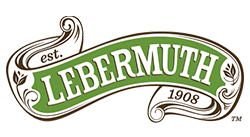Diversity and Inclusivity in Beauty
by Publication repost, on Apr 01, 2021
PUBLICATION REPOST l Mintel Diversity & Inclusivity Report 2021
Top Takeaways
1) A one size fits all approach to DEI falls flat with consumers
Understanding consumer perception toward inclusivity in beauty is complicated and nuanced. How consumers determine if a beauty brand is “inclusive” is largely dictated by whether the brand satisfies their own individual needs, thus challenging a “one size fits all” approach to inclusivity. Brands will have success when they are truly able to align their approach to inclusivity with the needs and expectations of their target audience.
2) Beauty brands are not going to be able to sit on the fence moving forward
Successful brands recognize the need to evolve with the changing demographic landscape in order to earn loyalty and stand out in the competitive market. Think of inclusive product portfolios as a long-term investment. While the initial cost can be substantial, particularly for small/indie brands, demonstrating a strong (and authentic) commitment to inclusion can be a compelling purchase motivator.
3) Brands have the opportunity to grow by inspiring and empowering consumers
Beauty marketing is shifting from “aspirational” to “inspirational”, and key audiences in the beauty space are inspired when brands show their commitment to diversity and inclusion. To start “moving the needle” integrate different types of beauty diversity at a time when it’s authentic for the brand. Brands must recognize committing to diversity is an ongoing practice.
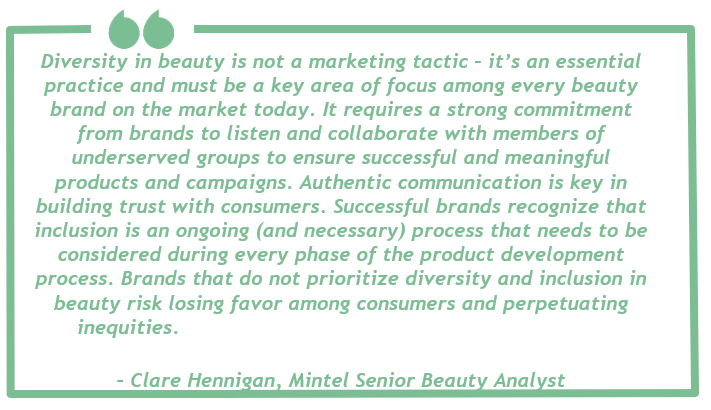
Impact of COVID-19
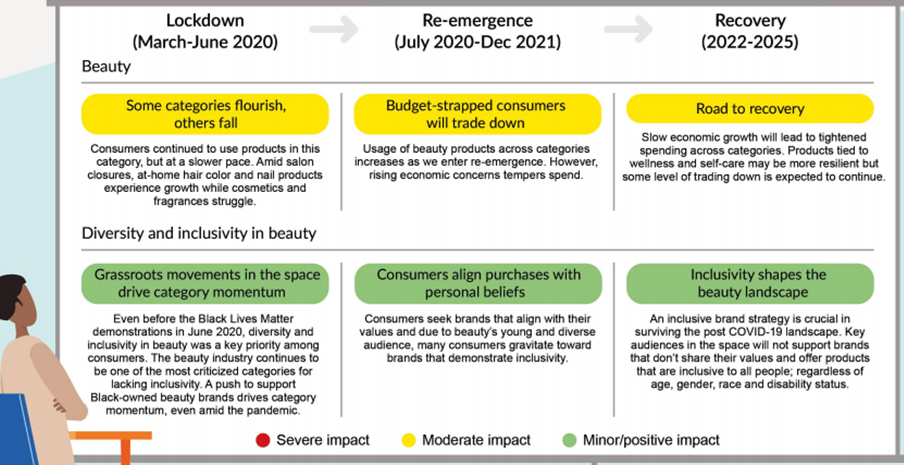
Inclusivity isn’t just about representation, it’s about accessibility
- Affordability is the top-cited indicator that a brand is inclusive, reinforcing the ongoing need for the beauty industry to break down barriers and improve accessibility to all adults. The economic downturn brought on by COVID-19 is disproportionately impacting key audiences in the beauty space. As a result, expect masstige brands to play a significant role in helping the beauty industry recover, as engaged consumers evaluate spending priorities.
- While product affordability is certainly a key factor in driving purchases for some consumers, others are more motivated to purchase from brands that reflect their personal values. This underscores the importance for brands to understand how their audience defines inclusivity and value. Adjust communication to meet the needs of customers to help encourage trade-ups and drive brand loyalty.
Brand Inclusivity Indicators, November 2020
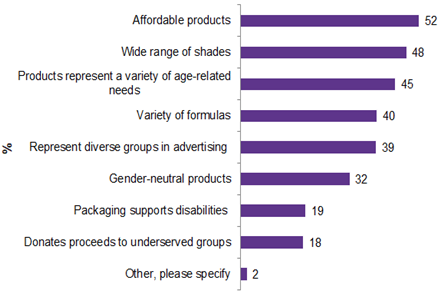
Inclusivity creates an opportunity for innovation
- Accessibility isn’t limited to income; both age and disability status can serve as
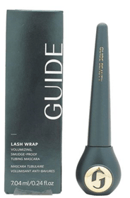 barriers to product usage and trial. Stand out in the crowded beauty space and make beauty routines easier for individuals with mobility challenges by offering disability-friendly packaging. 57% of adults agree there needs to be more beauty products for people with mobility challenges.
barriers to product usage and trial. Stand out in the crowded beauty space and make beauty routines easier for individuals with mobility challenges by offering disability-friendly packaging. 57% of adults agree there needs to be more beauty products for people with mobility challenges. - For example, after professional makeup artist Terri Bryant was diagnosed with Parkinson’s disease, she made it her mission to create products that could be applied with precision and ease. GUIDE BEAUTY uses inclusive design to bring the joy of makeup to everyone, regardless of skill set.
A one size fits all approach to DEI falls flat with consumers
- Understanding consumer perception toward diversity and inclusivity in beauty is complicated and nuanced. How consumers determine if a beauty brand is “inclusive” is largely dictated by whether the brand satisfies their own individual needs, thus challenging a “one size fits all” approach to inclusivity. For instance, older adults are more likely than their younger counterparts to view brands’ whose “products represent a wide variety of age related needs” as inclusive.
- This underscores the importance of understanding core audiences’ values and needs. Singular and “one and done” efforts are not going to resonate and will certainly not generate loyal customers. Brands will have success when they are truly able to align their approach to inclusivity with the needs and expectations of their target audience.
Beauty brands are not going to be able to sit on the fence moving forward
- Nearly half of beauty product users have looked for/shopped from brands with diversity or inclusivity in the past year. This aligns with the Respect Pillar from the Mintel Trend Driver Rights, which looks at how consumers are driven to buy from brands that share their values and cater to their choice of lifestyle.
- Furthermore, successful brands recognize the need to evolve with the changing demographic landscape in order to earn loyalty and stand out in the deeply competitive landscape. Think of inclusive product portfolios as a long-term investment. While the initial cost can be substantial, particularly for small/indie brands, demonstrating a strong (and authentic) commitment to inclusion can be a compelling purchase motivator.
Behaviors toward beauty brands, November 2020
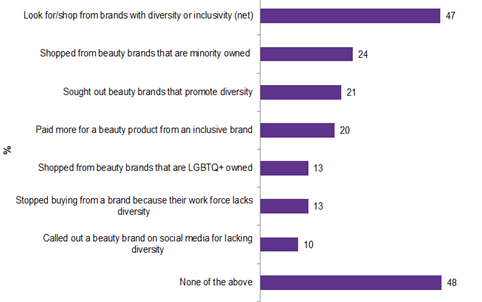
Beauty brands have the opportunity to grow by inspiring and empowering consumers
- 73% of adults agree the beauty industry plays on women’s insecurities and 72% agree society’s idea of beauty is too rigidly defined. Consumers want to see diversity in ads because it “reflects real life” and because “it shows that there are different ways to be beautiful”. As consumers become more aware of how unrealistic beauty standards impact self-esteem, expect a greater push for unedited/filtered beauty ads and more realistic portrayals of beauty.
- To key audiences in the beauty space, demonstrating different types of beauty diversity isn’t alienating, it’s empowering. To start “moving the needle”, integrate different types of beauty diversity at a time when its authentic for the brand – for example, waiting until pride month to promote gender-neutral products may feel like a marketing promotion instead of a brand value. Committing to diversity is an ongoing practice, and requires brands to listen to their audience to determine how efforts are perceived.
Diversity Motivators, November 2020
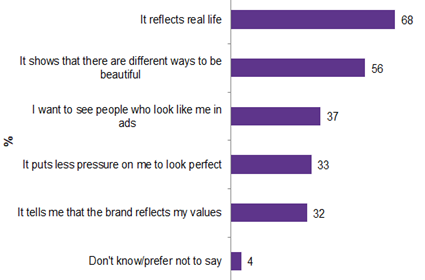
Source: Mintel GNPD
